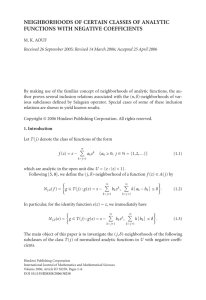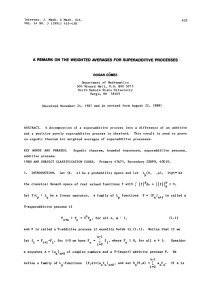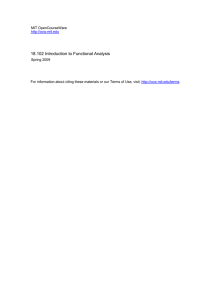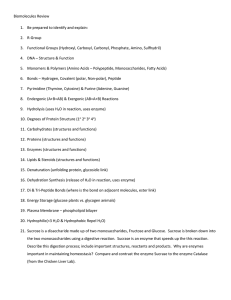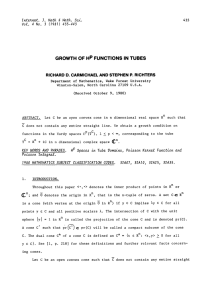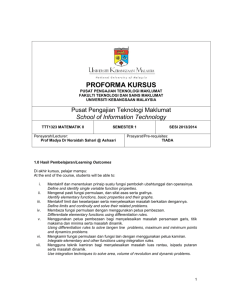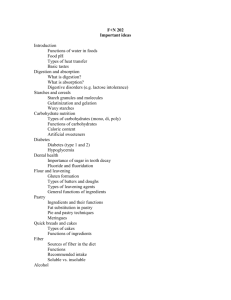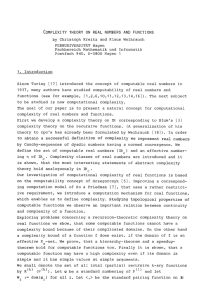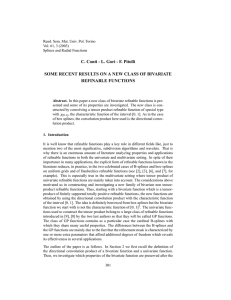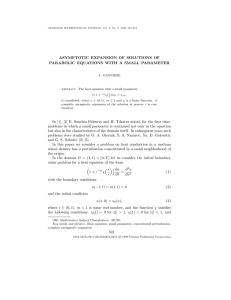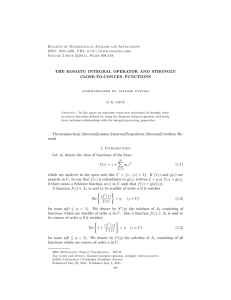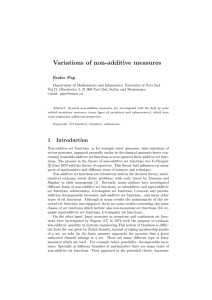<-,
advertisement
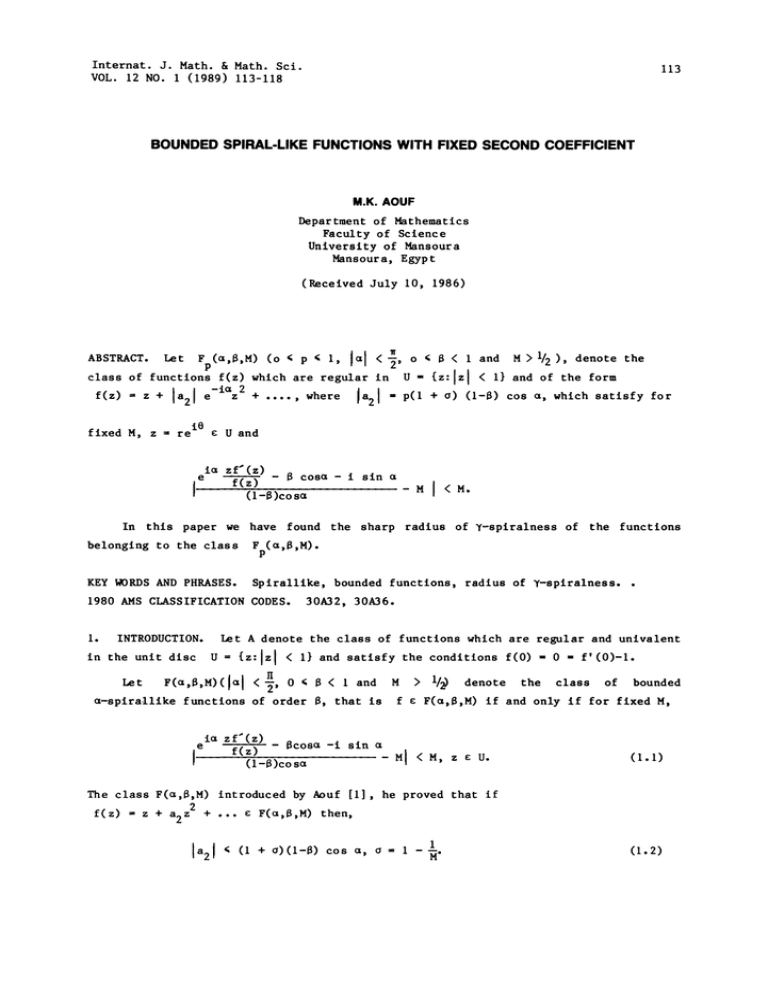
Internat. J. Math. & Math. Sci.
VOL. 12 NO.
(1989) 113-118
113
BOUNDED SPIRAL-LIKE FUNCTIONS WITH FIXED SECOND COEFFICIENT
M.K. AOUF
Department of Mathematics
Faculty of Sclence
University of Mansoura
Mansour a, Egypt
(Received July I0, 1986)
ABSTRACT.
F (c,B,M) (o
Let
(
P
p
(
I,
I(,I
<-,
U-
class of functions f(z) which are regular in
la 2
f(z)
z +
where
z +
la21 e-
fixed
M, z
H > I/2 ), denote the
I} and of the form
p(l + o)(I-8)cos (,, which satisfy for
(
o
la21-
<
B
and
{z:Iz <
e U and
re
e
ia
zf" (z)
B cosa- i sin
f(z)
(l-B)eo s
<
"
""
In this paper we have found the sharp radius of Y-splralness of the functions
F (a,8,M).
P
belonging to the class
KEY WORDS AND PHRASES.
Spfrallike, bounded functions, radius of Y-splralness.
1980 AMS CLASSIFICATION CODES.
I.
INTRODUCTION.
Let A denote the class of functions which are regular and univalent
< I} and satisfy the conditions f(O) 0 f’(O)-l.
{z:[z
F(e,8,M)(Ie
U
in the unit disc
<--,
Let
30A32, 30A36.
0
< 8
<
and
e-splralllke functions of order 8, that is
e
la
M
> I/@
F(,8,M)
f e
the
class
of
bounded
if and only if for fixed
M,
zf" (z)
8cos -i sin
f(z)
(l-)cosa
M
<
M, z e U.
F(a,B,M) introduced by Aouf [I], he proved that
z +
F(a,B,M) then,
a2 +
The class
f(z)
denote
(I.I)
if
z2
,la2l
< (1 + o)(1-8) cos a, o
--.
(1.2)
114
M.K. AOUF
f(z____)=
e F(a 8,M)
e-laz 2 +
la21
Thus without loss of generality we can replace the second
coefficient a of f(z) e F(=,,M) by
la21 e
2
Let F (a 8,M) denote the class of functions f(z)
z +
la21 e-laz 2
p
of (1.2) it
which satisfy (I.1), where
la21 p(t + o)(l 8) cos a. In
I.
follows that 0
p
z +
Let G (a 8,M) denote the class of functions g(z)
e -laz2 + .... regular
Ib21
p
U and satisfy the condition
is)
exp(-i arg a 2
whenever f(z)
F(a,,M).
If
E
then
z
+
view
(
in
zg" (z))
ela(l+
8cosa-i sin a
g’(z)
(1.3)
p(l+o)(l-6) cos a.
It follows from (I.I) and (1.3) that
g(z)
O
P
(a,B,M), if and only if zg’(z) e F (a,B,M).
(1.4)
P
We note that by giving specific values to
p,a,8 and M, we obtain the following
important subclasses studied by various authors in earlier papers:
(i)
FI(a,,M)
FM(a,)
and
GI(a,8,M) GM(a,8),
bounded splralllke functions of order
of order
are respectively the class of
and the class of bounded Robertson functions
6 investigated by Aouf [1] and
Fa, M and GI(a,O,M)
FI(a,O,M)
G
are respectively the class of bounded spirallike functions and the class of bounded
Robertson functions investigated by Kulshrestha [2].
and
Gp(a,, (R)) Op(a,8,),
are
considered
by
Omaranl
[3].
In this paper we determine the sharp radius of T-spiralness of the functions
F (a,8,M), generalizing an earlier result due to Kulshrestha
P
belonging to the class
[2], Llbera [4],
Umarani
[5,3].
he technique employed to obtain this result is similar to that used by McCarty
[6] and Umaranl [3].
2.
THE SHARP RADIUS OF Y-SPIRALNESS OF THE CLASS
LEMMA I.
If
f(z) e F (a,,M)M
P
>
I, then
F (a,,M), M
P
f(
>
oI o
I.
(2.1)
BOUNDED SPIRAL-LIKE FUNCTIONS WITH FIXED SECOND COEFFICIENT
115
where
(l+pr)
2
.1+o
w
e-lar2(r+p)
sin a}
{[(I-)(----) -i] cos a-i
(l-r2)(l+2pr + r2)
+
(2.2)
and
+o) 1-8 )co s r( +p r) (r+p)
2
2
1-r (1 +2p r+r
(2.3)
This result is sharp.
lw(z)
in U and
zf (z)
=.,_..
e
>
f(z) e F (a,8,M), M
P
< in U such that
Let
PROOF.
+
then there exists a function w(z) analytic
I.
1+o
(I-)(---) -11
cos
ow(z)
}+ i sin a, o
Ow(z)
or
.1+o
+ {[(l-)(--r-) -1] cos -i sin } e
zf’(z)
f(z)
Solving for
o w(z)
w(z),
zf’(z)
f(z)
w(z)
Since
laow(z)-
z +
f(z)
is analytic in
o[ zf’(z)
f(z) +
la21e-laz
(0)
U,
2
-1+o
{[l-B)(---)
+
p and
we obtain
]@(z)
-I] cos a-i sin a} e -la]
w(z)=pz +
in U.
l-p(#(z)-Pz)
Now
z+
z(z), where #(z)
z. Therefore
Izl.
and
I+o
+ {[(1-B)(---r- )-1] cos
h(z)
a-i sin
a}
e-tao
z
OZ
Izl
of
r under g(z) is a disc and h(z) is a billnear
zf’(z)
(hog) (z). That is, the image of
to
subordinate
is
transformation,
f(z)
zf’(z)
r under (hog)(z).
r under
f(. is contained in the image of
Since
the
image
then
Izl
zl
Equality in (2.1) can be attained by a function
.1+o.
f(z)
z(1-2poz+Oz 2)
-(-) (l-8)co sae
-i a
(2.4)
iI
M.K. AOUF
-iz2+.
z + p(l+o)(l-B)cosa e
hence
f." (z,)=
z
l-2po,
LZ+Z2--(I +0) (I--8)C0 sa e -isz(z-p)
l-2p oz + oz 2
f(z)
+
o -(l+o)(1-B)cos a e
+o
z(z-p)
where
Since
igpO z
I, 0
p
<
O
I,
II
<
for
z
U.
This shows that
la
zf’(z)=
f(z)
1+o
+
[-(--T-)(-)]
cos
o(z)
+ i
+ o(z)
sin
and
e
ia
zf" (z)
i sin-Bcos
f(z)
-$(z)_
+o(z)
(1-S)co s
,II
Then it is easy to show that
6(
@
Substituting
o
zf" (z)
WoI=P
’
e
0
-ode
where
MI
’ 0(’’)
is)
t)
Wo
9(z)
and
M
r(.r+p)
where 6
po
<
l+rp
o"
-
Thus
f
F (a,B,M).
p
(2.5), we find that
in
are given by (2.2) and (2.3).
This completes the proof of the lemma.
REMARK I.
(I) If p-I and
(ll) If
(ill)If
8=0 in Lemma I, we obtain a result of Kulshrestha [2].
M -(R)(o=I) in Lemma I, we obtain a result of Umarani [3].
a=0 and
M--(o=I) in Lemma I, we obtain a result of McCarty [6].
If f(z) e F (a,B.M) >
then f(z) is y-spiral
p
is the smallest positive root of the equation
where
THEOREM I.
< ry,
ry
cos Y + p [2 cos Y
[p
2
cos Y
(l+o)(l-8)cosa]r +
+ cp2 -(I + o)(1-6)cos a(l+
3
+p [2c-(l+o)(l-8)cosa]r +
cr4=O,
p2)]
r
2
(2.6)
BOUNDED SPIRAL-LIKE FUNCTIONS WITH FIXED SECOND COEFFICIENT
where
cos(Y-2a) +
c
cos a cos(Y-a).
>
F (a,8,M), M
P
Let f(z)
PROOF.
.1+o
[(I-B)(----)-2]
I,
117
The result is sharp.
then by the above Lemma, we have
zf’(z)
Hence
Re e
zf" (z)
iy
Re e
f(z)
iy
w
p
o
-1+o
(l+pr)2+Re {[(I-8)(---)-I]
cos Y
o
cosa-i sin a}
el(Y-a) r2(r+p)
-( +o) 1-8 )co sar( +p r) (r+p)
r2)(I
(I
cos
Y(l+pr)2+
+ 2pr + r 2)
{cos(Y-2a) +
[-(1+o)(1-8)cosa
(I
r
2)
.1+o-
[(I-8)(---)-2]
r(1+pr)(r+p)
(I + 2pr + r
(2.7)
2)
f(z) is Y-splral if the R.H.S. of (2.7) is positive.
Izl
< ry
where
cos Y (l+pr)
2
(y-a)}r2(r+p)
cos a cos
ry
Hence f(z) is Y-splral
for
is the smallest positive root of the equation
[(1-8)(I--+o)-2]
+{cos(Y-2a)+
-(1+o)(1-8)cosa r(l+pr)(r+p)
cosa cos(Y-a)},
r2(r+p) 2
0.
Simplifying the above equation, we obtain (2.6).
If YffiO in the above theorem, we obtain the radius of starllkeness of the class
F
p
COROLLARY I.
f(z) e F (a,8,H), H
p
>
I,
is starllke for
Izl
( r
o
where
r
o
is the least positive root of the equation
l+p [2-(l+o)(1-8)cosa]r +
()(I-8)
cos a [cos ap
r3+cr4
p[2c-(l+o)(l-8)cos a]
where
c
.1+o
(----)(I-8)
If p=l, Y=0 and
COROLLARY 2.
2
f(z)
o
(l+p2)]r2+
I, we obtain a result
I, is starllke for
in Theorem
F
a,M’ H >
least positive root of the equation
l-(l+o)cos a
(2.8)
O,
-I.
cos a
8--0
2
r+[t----)cos2a- I] r2=O.
Izl
of Kulshrestha [2].
<
to,
where
r
o
is
the
118
M.K. AOUF
REMARK 2.
(i)
(=1) in Theorem 1, we obtain a result of Umarani [3].
(=1) in Theorem 1, we obtain a result of Libera [4] and
H
H
If
(ii) If p=l and
Umaranl
5].
(iii)
=0,
If p=l,
Y=0
(o-l) in Theorem 1, we obtain a result of
H
and
Robertson [7 ].
Since
(
(,,H),
If g(z)
TEEOREM 2.
Iz
G (,B,M) if and only if zg*(g)
g(z)
where
rT
H)
Fp(U,,M)e
I, then Re
e
i(
/
obtain from Theorem
g’(z)"
I,
) 0 for
is the least positive root of equation (2.6).
The result is sharp.
If =0 in Theorem 2, we obtain the radius of convexity of the class
G (,,M), M
P
the least positive root of equation (2.8).
COROLLARY 3.
g(z)
If
>
p
1, then the radius of convexity of g(z) is
REMA 3.
Ms (o=I) in Theorem 2, and Corollary 3, we obtain a results of Umarani
For
[31
(ll) :f p-I and
6=0 in Corollary 3, we obtain a result of Kulshrestha [2].
(=1), Theorem 2, generallzes the result of Umaranl [5].
(ill)For p=l and M
REFERENCES
I.
AOUF, M.K.
2.
KULSHRESTHA,
Bounded p-valent Bobertson functions of order
a,
Indlan. J. o.f..Pure
and Appl. at_h_s., 16 (1985), 775-790.
P.K.
Bounded
Robertson
functions,
Rend.
di
Matematica,
.(6)9,
(1976), 137-150.
3.
bIARANI,
Pur..e
P.G.
Splra1-11ke functions with fixed second coefficient, I.ndlan J.
13(3____) (1982), 370-374.
Univalent a-spiral functions, Canad. J. Math. 1__9 (1967), 449-456.
appl, Math.
4.
LIBERA, R.J.
5.
[MARANI,
P.G.
Some
studies
in univalent
functions,
Ph.D.
Thesis,
Karnataka
University, Dharwad (1976).
6.
7.
McCARTY, C.P. Two radius of convexity problems, Proc. Amer. Hath. Soc. 42
(197 2), 153-160.
ROBERTSON, M.S. Radii of starllkeness and close-to-convexlty, Proc. Amer. Math.
Soc. 16 (1965), 847-852.
